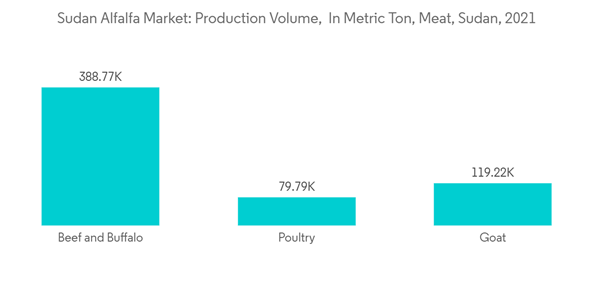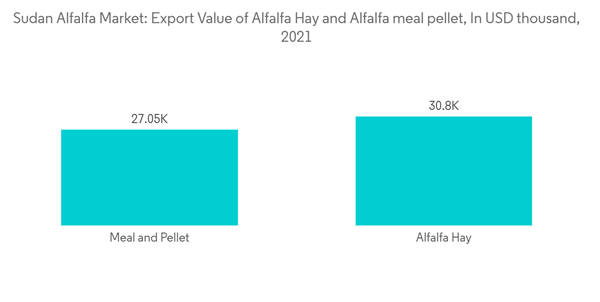Key Highlights
- Alfalfa is native to warmer temperate climates, widely grown in the Northern and Central parts of the country. Historically, alfalfa was grown by small farmers using river or bore water. Those farmers used surface (canal) irrigation to water the crop. But with the growing demand for the crop, businesses started to irrigate their wide fields through center pivots that now spread widely in the country.
- The major factors influencing the alfalfa hay market include the increasing demand for quality hay for livestock and cattle population, prices of alfalfa hay, and price trends in alternative feed and forage.
- According to various research studies, feeding alfalfa hay enhances the growth and development of animals at a faster rate and improves milk productivity. This increased demand for alfalfa hay, especially for feeding cattle and horses.
- The production of alfalfa in Sudan is showcasing a consistently increasing trend. One of the main driving factors is the increasing investments in the country by various foreign firms, especially from the GCC (Gulf Cooperation Council) countries. Currently, there are no imports of alfalfa into the country. However, the country imports seeds for cultivating alfalfa from other countries, such as Australia, the United States, and the United Arab Emirates.
Sudan Alfalfa Market Trends
Raising Demand for Meat and Diary Product
- Sudanese household food demand focuses on aggregated food items such as cereals, meat, milk, and eggs. Food consumption patterns have changed due to increased income and adverse rural-urban migration.
- The country has one of the largest livestock populations in the country. Hence, the country exports live animals and chilled meat to the United Arab Emirates, Qatar, Kuwait, Oman, Jordan, and Abu Dhabi. According to the International Trade Center (ITC) Trade map, Sudan exported total meat and edible meat offal worth 66,641 USD thousand in 2021. Egypt remains the major export destination for meat, followed by the United Arab Emirates in the same year.
- Poultry meat and eggs have assumed increasing importance in the Sudanese economy and Sudanese diets in recent years. Some of the firms engaged in alfalfa production have also initiated dairy farming locally in Sudan to export value-added live calves and meat products, especially to countries such as United Arab Emirates, Qatar, and Saudi Arabia.
Increasing Production within the Country
- The production of alfalfa in Sudan is showcasing a consistently increasing trend. One of the major driving factors is the increasing investments in the country by various foreign firms, especially from the GCC countries. Khartoum is one of the major states in Sudan, with a share of more than 50% of total forage crop cultivation in the country.
- This high demand has prompted local and foreign entrepreneurs on a large scale in several parts of the country. Investors have recently launched large-scale farms around Khartoum and in the North to cover the mounting demand for alfalfa in the region. The West Omdurman in Khartoum has a 10,000-acre fodder farm projected to generate an annual profit of USD 20.0 million.
- Also, Amtar (rains) grows alfalfa on a big farm in North Kordofan in the Midwest, using center-pivot irrigation from bore water. The Amtar farm operators project to export 20,000 fattened calves a month. Further, UAE-based companies like Amtaar Investment and GLB started investing in Sudanese land for forage production. The companies widely adopt centralized pivots toward increasing productivity through improved water usage efficiency.
Sudan Alfalfa Industry Overview
Additional Benefits:
- The market estimate (ME) sheet in Excel format
- 3 months of analyst support
This product will be delivered within 2 business days.










